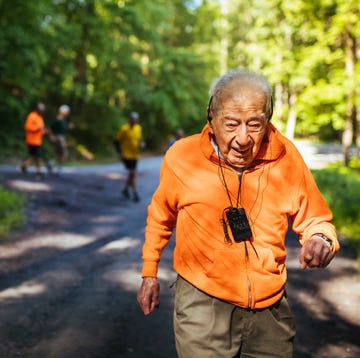Victor Asenov endured the agony of repeatedly running and hiking to the summit of a mountain last weekend even though he couldn’t take in the scenery that was unfolding around him.
The 29-year-old Bulgarian, who has been blind since birth, battled sleeplessness and exhaustion for nearly two full days ascending and descending 7,500-foot Vitosha Mountain near the city of Sofia with the hope that other vision-impaired individuals could one day experience the mountains with guide dogs.
With help from a dedicated support crew, and briefly his own reliable guide dog, Tady, Asenov ran and hiked 19 laps up and down the snow-covered surface of the mountain on March 21-23 to cover the vertical gain equivalent to the the 29,028-foot elevation of Mt. Everest.
Stopping only to refuel and rehydrate but not to sleep, Asenov gained approximately 1,550 vertical feet over roughly 1.95 miles on each ascent (and lost the same amount going back down to the start), to become the first blind person known to have achieved the distinction known as “Everesting.”
In all, he covered about 75 miles on foot over 46 hours between early Friday morning and early Sunday morning. He ascended and descended approximately 29,500 vertical feet along the way.
Asenov attempted the feat to raise money for a guide dog school at the Eyes on Four Paws Foundation in Sofia, the only school of its kind in the Balkan nation. Tady, who made one of the 19 trips to the summit of the climb with him, has been training at the school for nearly three years.
“For me, running in the mountains is my favorite activity,” Asenov told Runner’s World. “I was inspired by the desire to support the guide dog school. Also, the fact that I love big challenges—mostly in the mountains. And especially if it’s something that hasn’t been done before.”
Tethered to a guide and accompanied by another one on every roundtrip, Asenov covered the entire route by running and walking, even though official Everesting rules allow for mechanized travel on the descents. Asenov wore a pair of Decathlon Forclaz hiking shoes with snow crampons he bought the day before the event, but didn’t have any issues at all.
He refueled along the way on energy bars and gels while rehydrating with water and tea. His support team made him sandwiches and omelets to eat at the mountain huts at the bottom and the top of each climb, but at one point they surprised him with a hot serving of mishmash, a traditional Bulgarian dish made with eggs, fresh vegetables, and sirene cheese.
Asenov said achieving the Everesting designation was perhaps slightly easier to do in winter because the groomed snow terrain required less need for the guides to constantly call out every footstep around rocks, roots, and other obstacles.
Taking a snowmobile back down to the bottom of each climb was an option for Asenov, but he refused even when he found himself sleepwalking during the 15th and 16th laps early Sunday morning before sunrise.
“By using a snowmobile he could have saved like half of the time, distance and effort,” said Bozhidar Kartunov, who helped organize the event and support Asenov during the endeavor. “But he didn't even want to talk about it because he didn’t want to create harm to the environment with the snowmobile exhaust.”
Everesting 101
The concept of Everesting dates back to 1994, when George Mallory, the grandson of legendary British mountaineer George Mallory, hiked up and down a 3,500-foot section of Australia’s Mount Donna Buang eight consecutive times without sleep to reach the lofty total of vertical gain equivalent to the height of Mount Everest.
Australian cyclist Andy van Bergen formally organized the concept in 2012 with guidelines and rules, and it started to become popular in cycling circles as a difficult training challenge. But then amid the worldwide shutdown during the Covid-19 pandemic, it also boomed among hikers, trail runners, and uphill skiers.
When it comes to running, Simon Grimstrup holds the Everesting world record from his 2021 effort running up and down a hill in Denmark 202 times for 29,028 feet of vertical gain in 10 hours, 45 minutes and 14 seconds.
Any runner, hiker, or cyclists can attempt an Everesting attempt, but all activities must be logged on Strava—unless you take part in virtual Everesting, which must be logged on an app like Zwift. Runners, hikers, and cyclists must reach 29,028 feet of elevation gain in one single climb of any distance on the same road, trail, or section of a mountain.
There had been plans for the first official in-person Everesting 48-Hour Challenge event from May 29 to June 1 in Andorra, but it has been postponed. In its place, an Everesting x Strava 30-day cycling challenge.
Access to the Mountains
Asenov said he’s enjoyed spending time in the mountains since he was a young boy, and that’s made him a strong advocate for individuals who might not have easy access. He’s already worked with officials in Sofia to make the city more accessible to people with disabilities and believes the guide dog school can be a key way to reduce the challenges of getting onto trails.
While Asenov has become an accomplished trail runner since 2022—having completed several rigorous trail running races—he requires the assistance of a guide any time he goes out running. However, he started to train Tady, a four-and-a-half year-old labrador, to help him navigate while he is hiking on the technical trails in the mountains near Sofia.
Kartunov met Asenov in 2023 when both were running in the Tour de Vitosha. In the interim, Kartunov started an organization called Sports Heroes aimed at helping young Bulgarian athletes become positive role models, and he eventually circled back to Asenov in February with the Everesting idea.
“He told me about the Everesting challenge and asked if I thought I could do it. Without thinking, I replied: ‘Yes, let’s do it,’ and we immediately started organizing,” said Asenov, who works as a massage therapist in Sofia. “The special thing about running is that I’m dependent on other people because I have to run with a pacer. That’s why I don’t have the opportunity to run often. Basically, I train from race to race.”
The longest race Asenov has participated in is the Persenk Ultra, a 99-mile race in Bulgaria’s Rhodope Mountains with 19,700 feet of vertical gain. Last year, he completed the Pirin Ultra, a 41-mile race with 14,000 feet of vertical gain, and he completed a duathlon at the Tour de Vitosha, which included a 62-mile bike ride (on a tandem bike with a partner) followed by a 62-mile run. He has also hiked above 17,000 feet in Nepal in 2019, and he hopes to reach the summit of 19,341-foot Mount Kilimanjaro in Tanzania some day.
Asenov admits he doesn’t like training in the gym, but he says he had spent the winter participating in local 5K parkrun events. His longest training event for his Everesting attempt was a three-day, 285-mile tandem bike from Sofia to Shipka and back.
“Victor is impressive and has once again shown that there are no limits before him,” Kartunov said. “Beyond his achievement, the best thing about these exciting days on Vitosha is the victory of good. So many people came together and stepped up to help—each with what they could, and their energy gave Victor strength and gave him wings.”













